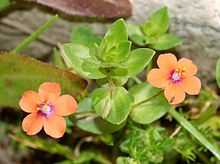Anagallis arvensis
| Scarlet pimpernel | |
|---|---|
 | |
| Scientific classification | |
| Kingdom: | Plantae |
| (unranked): | Angiosperms |
| (unranked): | Eudicots |
| (unranked): | Asterids |
| Order: | Ericales |
| Family: | Primulaceae |
| Genus: | Anagallis |
| Species: | A. arvensis |
| Binomial name | |
| Anagallis arvensis L. | |
Scarlet pimpernel (Anagallis arvensis; also known as red pimpernel, red chickweed, poorman's barometer, poor man's weather-glass,[1] shepherd's weather glass or shepherd's clock) is a low-growing annual plant. The native range of the species is Europe and Western Asia and North Africa.[2] The species has been distributed widely by humans, either deliberately as an ornamental flower or accidentally.[3] A. arvensis is now naturalised almost worldwide, with a range that encompasses the Americas, Central and East Asia, the Indian Subcontinent, Malesia, the Pacific Islands, Australasia and Southern Africa.[4][5][6]
Traditionally included in the family Primulaceae, the genus Anagallis was placed in the family Myrsinaceae[7] until that family was included in Primulaceae in the APG III system.
This common European plant is generally considered a weed and is an indicator of light soils. The origin of the pimpernel name comes from pympernele [1400–50]; late Middle English, derived from Middle French pimprenelle, Old French piprenelle; Vulgar Latin *piperīnella= Latin piper pepper + -īn- -ine + -ella diminutive suffix.
It is most well known for being the emblem of the fictional hero the Scarlet Pimpernel.
Description
Scarlet pimpernel has weak sprawling stems growing to about 50 cm (20in.) long, which bear bright green ovate sessile leaves in opposite pairs. The small orange, red or blue flowers are produced in the leaf axils from spring to autumn. The petal margins are somewhat crenate and have small glandular hairs. Blue-flowered plants (A. arvensis Forma azurea) are common in some areas, such as the Mediterranean region, and should not be confused with the related Blue pimpernel, Anagallis foemina, sometimes ssp. foemina. In 2007, a molecular phylogenetic study showed that Anagallis foemina is more closely related to Anagallis monelli than to Anagallis arvensis, and should be treated as a separate species.[8] Scarlet pimpernel flowers are open only when the sun shines.[1]
In literature
Scarlet pimpernel (anicham in Tamil) is one of the two flowers mentioned in the Tirukkural.
References
- ↑ 1.0 1.1 "Scarlet Pimpernel (Anagallis arvensis)". Connecticut Botanical Society.
- ↑ "Factsheet - Anagallis arvensis".
- ↑ "Angallis arvensis (Scarlet pimpernel)".
- ↑ "Descriptions and articles about the Scarlet Pimpernel (Anagallis arvensis) - Encyclopedia of Life". Encyclopedia of Life.
- ↑ "Anagallis arvensis in Flora of North America @ efloras.org".
- ↑ http://keys.lucidcentral.org/keys/v3/UQCentenary/key/UQ_Centenary/Media/Html/anagallisarvensis.htm
- ↑ Mari Källersjö, Gullevi Bergqvist and Arne A. Anderberg (2000). "Generic realignment in primuloid families of the Ericales s.l.: a phylogenetic analysis based on DNA sequences from three chloroplast genes and morphology". American Journal of Botany (American Journal of Botany, Vol. 87, No. 9) 87 (9): 1325–1341. doi:10.2307/2656725. JSTOR 2656725. PMID 10991903. (full pdf.text)
- ↑ Manns, Ulrika; Anderberg, Arne A. (2007). "Relationships of Anagallis foemina and Anagallis arvensis (Myrsinaceae): New insights inferred from DNA sequence data". Molecular Phylogenetics and Evolution 45 (3): 971–980. doi:10.1016/j.mpev.2007.07.022. PMID 17869544.
Sources
- Blanchan, Neltje (2005). Wild Flowers Worth Knowing. Project Gutenberg Literary Archive Foundation.
- Harvey Wickes Felter and John Uri Lloyd (1898) King's American Dispensatory.
- Ulrika Manns and Arne A. Anderberg (2005). "Molecular Phylogeny of Anagallis (Myrsinaceae) Based on ITS, trnL-F, and ndhF Sequence Data". International Journal of Plant Sciences 166 (6): 1019–1028. doi:10.1086/449318.
External links
| Wikimedia Commons has media related to Anagallis arvensis. |
